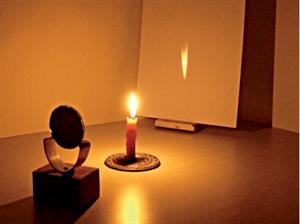PDF chapter test TRY NOW
Consider the following activity to understand the image formed by a spherical mirror.
Hold a concave mirror or convex lens (or place it in a stand). Its reflecting surface should face the sun. The light reflected by the mirror should be directed onto a sheet of paper held close to the mirror. Gradually move the sheet of paper back and forth until a bright, sharp spot of light appears on the paper. For a few moments, keep the mirror and the paper in the same place.

By using convex lens
What do you observe? Why does the paper catch fire?
We saw how a concave mirror could focus parallel sunlight rays into a single point. Now, in front of the concave mirror, place a lit candle and a white screen. Adjust the screen's position. The front and backward movement of the screen is possible. Take note of the size and shape of the image. A small and inverted image can be seen.

An image formed by a concave mirror
Bring the candle closer to the mirror slowly. What are your observations?
The image grows larger as you bring the object closer to the mirror. When you bring the candle very close to the mirror, try to find the image. Is there an image on the screen that you can see? Take a look at yourself in the mirror now. What do you see? The candle appears as an erect, magnified image. On the screen, an image is obtained in some of the object's positions. However, at some of the object's positions, no image is obtained.
The behaviour of the concave mirror is more complicated than that of the plane mirror. However, we can simplify and understand the behaviour of the image formed by a concave mirror by employing geometrical techniques. We only used two rays in the plane mirror to figure out how to get a complete image of a person. However, in order to comprehend the nature of an image formed by a spherical mirror, we need to look at four specific rules.
We will discuss the rules for making a ray diagram in the next section.
